by Winding Pathways | Sep 30, 2021 | Garden/Yard, Nature, Pests
Poison ivy is a universally disliked and feared plant. It seems to grow everywhere. Encounter it and risk an itchy rash…..or worse. Some people are so sensitive to the oil on the leaf’s surface that they end up hospitalized.
Despite the discomfort it causes, poison ivy is an amazing native plant. It’s tough and thrives in any soil type, in drought or deluges. It loves living in the woods, at the edge of lawns and ballfields, and even in city vacant lots. It grows along ocean beaches and up mountains.
Scratching people may disagree, but there are two things to love about poison ivy. Both happen in the fall.

Keep your distance from this beguiling, colorful plant.
As days become cooler and daylight shortens poison ivy is one of the first plants to turn color. A month before sugar maples color up poison ivy leaves turn a glorious deep red. By late fall birds enjoy eating plentiful poison ivy berries. Apparently, they don’t get the itch and happily spread the common plant’s seeds when they poop them out.
There is one certain way to prevent a poison ivy itch. Enjoy it from a distance. Only contact with the plant’s oil can cause a rash. This can happen by touching the plant leaves or vines, patting an animal that has run through a poison ivy patch, accidentally touching clothes that have rubbed by poison ivy, or by breathing smoke with the oils in it when an area is being burned has poison ivy in it.
by Winding Pathways | Jul 15, 2021 | (Sub)Urban Homesteading, Foraging, Nature
We take a walk every day, sometimes through urban and industrial areas. Other days find us on prairie or woodland trails. Everywhere we’re spotting an abundance of summer fruit being devoured by birds, woodchucks, chipmunks, and even deer.
Last August 10 a terrible derecho roared through our area, felling about 70% of mature trees. It seemed tragic but a year later vegetation has responded with enthusiasm in former shady places now sunlit. These include berries. Brambles: Newly sunny woods are filled with first-year black raspberry and blackberry canes. Next year there’ll be an abundance of berries. These are delicious food for people and wildlife. We like them fresh.
Here are few other species of berries. Some are human edibles. Others leave for the birds.
Munching
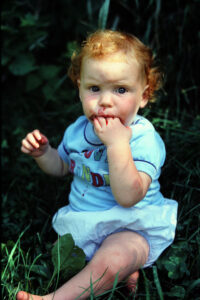
The sweet, but bland mulberries are children’s favorite.
Mulberries: These deliciously sweet, but bland, fruits have a long bearing season that’s mostly in June but lingers well into July. Robins just love them. So do many other birds……and children. Mulberries are a delicious underused human food. One of our favorite dishes is rhubarb mulberry pie.
Cherries: Many birds love domestic cherries. Our trees were almost ready to pick when a family of raccoons did the picking for us. No cherry pies this year. Wild black cherries are common. They’re edible to humans but are small, have a big pit, and are usually bitter. They’re hardly worth the effort to pick and process so we leave them for the birds to enjoy.
Leave These for the Wildlife
Chokecherries: They ripen in late June and into July. These pucker up any human trying to eat them, but birds love snacking on them.
Elderberries: These shrubs love trail and roadside sun and produce bunches of berries in late summer and into fall. Some people go to the trouble of making wine or jam from them but we leave them for the birds to enjoy.
Poison Ivy: Another berry to leave to the birds is poison ivy. This favorite of birds is how the plant spreads when the birds drop seeds. Leaves of three? Let them be!
-
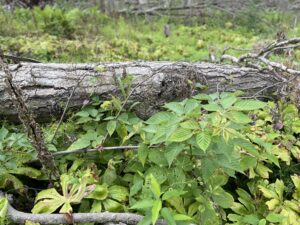
-
Berry canes emerge in the sun.
-
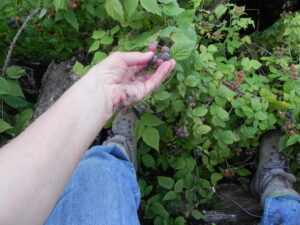
-
We bring along a small bag to bring home berries.
-
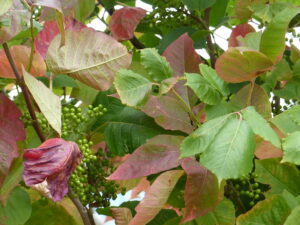
-
Birds spread poison ivy by eating the berries and pooping the seeds out later.
Dogwoods: These berries aren’t human food but make delicious bird chow. They ripen late and stay on the shrub through winter. Want to find bluebirds or robins on a cold January day? Find a patch of dogwoods that still have frozen berries clinging to them.
Winter Food
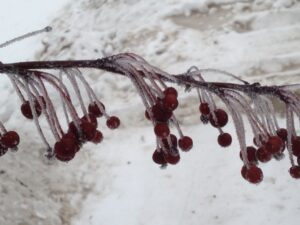
Waxwings flock to winter berries.
Highbush Cranberries: Look from late July on as they ripen in mid to late summer. A wildlife favorite, birds and chipmunks forage happily in the shrubs. Some berries linger into winter and often wintering waxwings greedily forage on the berries. Deer come by and munch both the leaves and berries.
When we set off on a summer walk, we stuff a bag or two into our pockets. Then, if we discover a blackberry patch, we’ve got a way to carry a few handfuls home.
by Winding Pathways | Jun 28, 2018 | Nature, Pests, Trees/Shrubs
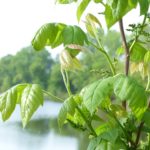
Poison Ivy loves edges
This summer millions of Americans will have unhappy encounters with poison ivy. For most people, the result is a patch of itchy bumpy skin that goes away after a few days to a week or so. Unfortunate others will develop a serious reaction that includes severe itching and swelling.
The very best way to not get a case of poison ivy is to avoid the plant and its culprit – urushiol, an oil that causes the allergic reaction. It’s on the plant’s leaves, in the vines and the sap.
Avoiding urushiol is a surefire way of avoiding a poison ivy rash, but many people have trouble identifying the plant. Fortunately, poison ivy has a secret. Knowing it helps people avoid the plant.
Poison ivy is an amazingly adaptable, hardy and confusing plant. It can be a low growing ankle high sprig, a shoulder high shrub, or a vine winding up to the top of a tall tree. The old saying “Leaves of three, let them be” is only partially helpful in identifying the plant. Usually, it does have leaves in groups of three but many animals love dining on poison ivy and are immune to its ill effects. So, a rabbit or deer may have eaten a leaf, giving the plant leaves of two! And many nonpoisonous plants have leaves of three.
Enter the plant’s secret. Poison ivy is a plant of the edge. It’s rare in the middle of a sun-soaked prairie or in a deeply shaded forest. The plant almost always hugs the edge of a habitat, especially if it gets partial sunshine.
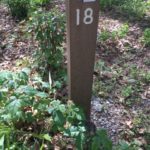
Birds drop seeds when they perch on campground posts.
We’ve seen poison ivy on the edges of:
- Lawns, including ours
- The ocean sand dunes
- Lakes, especially along trails
- Roads
- Trails anywhere
- Ballfields – the rough where balls sometimes go
- Picnic areas
- It especially seems to love life in state park campgrounds especially around the posts that mark a site number and the trees that shade a campground area and that kids love to hug!
So, to avoid poison ivy be especially cautious on the edge. Look carefully at edge plants and study photos of poison ivy in books and on the Internet. Avoid poison ivy when you can.
But, if you accidentally touch the plant or have been wading through likely habitat, get home soon, remove clothes carefully, avoiding touching the outsides of clothes where poison ivy sap may have touched, take a sudsy shower, toss the towels in the laundry, and odds are good that the oil will be soaped off before it creates an allergic reaction.








